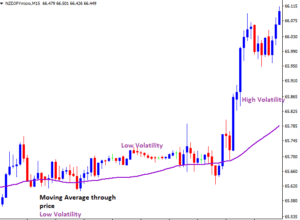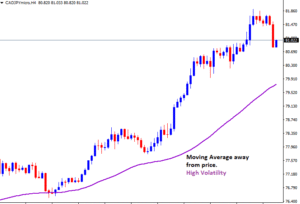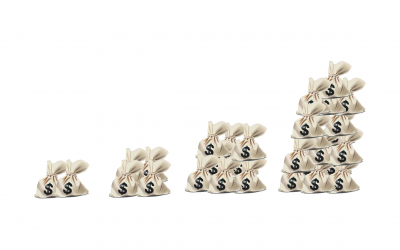You can measure Volatility using Moving Averages in Forex by looking at how far Moving averages are from Price. The further they are, the higher the volatility.
First,
let’s have a small recap of what MAs are before we dig deep on how to measure Volatility using moving averages.
what are Moving Averages (MAs)
Moving Average is a trend following indicator that measures the direction of a trend.
In an uptrend, the moving average moves just below the price action and in a downtrend above.
When you look at moving averages movement with price, you can easily tell how much volatility is in the market.
The 3 common types of moving Averages include;
- Simple moving average (SMA)
- Exponential moving average (EMA) and
- Weighted Moving Average(WMA)
Moving averages are used to measure the average movement of the market for the estimated period of time.
For example, a 14-day Simple moving average is got by plotting the average price of every 14 days.
How to use moving averages to measure market Volatility
Take a look at the EURCAD, Hourly chart below;

The distance between the moving average and the price shows the volatility of the currency pair.
From the chart above, as the moving average moves a way from price, it indicates high volatility in the market.
On the other hand, if it gets close or passes through price, it shows low volatility in the market.
Periods of Low Volatility in the market
The moving averages gets closer to price or moves through price.
This low volatility is usually a congestion period on the forex market charts.
Take a look at the chart below,

Periods of high volatility in the market
The moving average moves further from price or expands.
This is phase of strong price momentum mostly from breakouts after congestion periods.
See chart below;

Therefore,
With the moving average on the chart, you can tell if the currency pair has low or high volatility depending on how close the moving average is to price.
Why you make small profits and take big losses?
Major Reason why You make Small profits and take Big Losses in Forex is because you have lost market objectivity. This is due the influence of greed, fear, regret and revenge. You trade what you are thinking instead of what you see! The problem is that traders want to...
- Oh, bother! No topics were found here.



